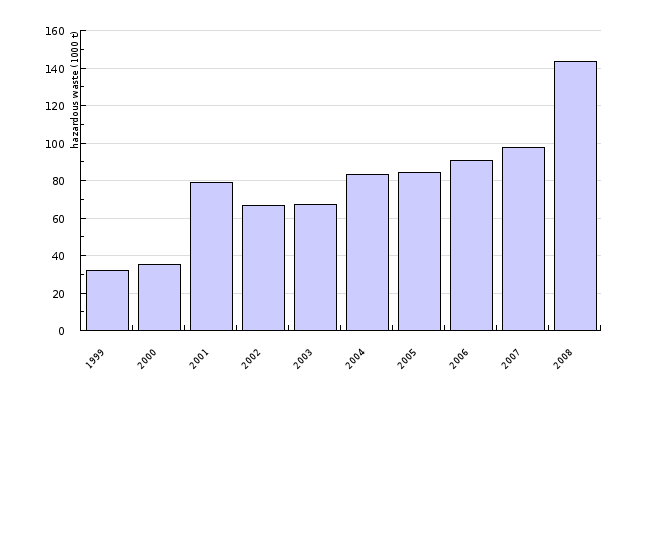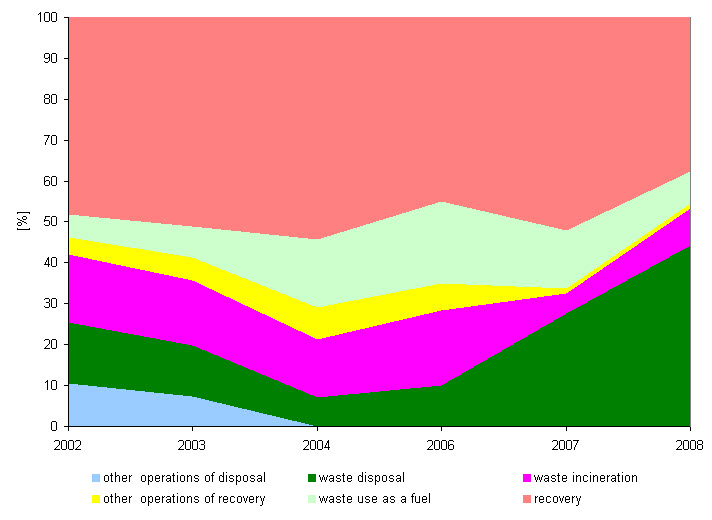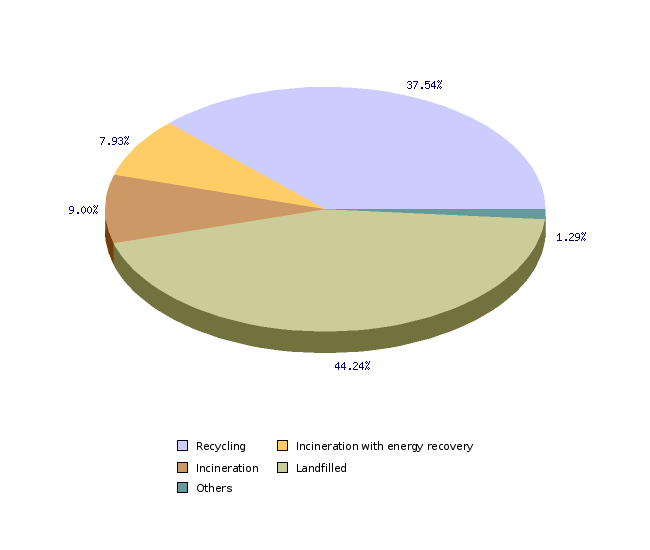[OD03] Hazardous waste

Key message

The quantities of hazardous waste are increasing. Because of the contained environmentally dangerous substances hazardous waste has to be collected, recovered or deposited separate from other waste. In 2008, the quantity of generated hazardous waste increased by 47% compared to 2007 and amounted to 143,000 tonnes. The reason for such increase was hazardous waste and soils from the site restoration of tar disposal landfill in Pesnica and construction waste (containing asbestos) after heavy thunderstorms. 47 % of hazardous waste was recovered and 53% deposited.
Definition
The indicator shows the quantity of generated hazardous waste and the manners of treatment of hazardous waste.
Hazardous waste has one or more hazardous characteristics which are harmful to health and/or the environment (e.g. flammability, irritancy, toxicity, mutagenicity, oxidizing properties, infectivity, etc.). Mandatory management of hazardous waste is specified in the Decree on waste management (Official Gazette of the Republic of Slovenia, No. 34/08). The Annex to the Decree contains a list of hazardous waste including the list of properties due to which such waste is classified as hazardous waste.
Charts
Waste Management Database, Environmental Agency of the Republic of Slovenia, 2009
| 1999 | 2000 | 2001 | 2002 | 2003 | 2004 | 2005 | 2006 | 2007 | 2008 | ||
|---|---|---|---|---|---|---|---|---|---|---|---|
| hazardous waste generated | 1000 t | 31.97 | 35.382 | 78.885 | 66.779 | 67.1 | 83.064 | 84.397 | 90.9 | 97.68 | 143.695 |
Waste Management Database, Environmental Agency of the Republic of Slovenia, 2009
| 2002 | 2003 | 2004 | 2006 | 2007 | 2008 | ||
|---|---|---|---|---|---|---|---|
| other operations of disposal | % | 10.5 | 7.4 | 0 | 0 | 0 | 0 |
| waste disposal | % | 14.9 | 12.4 | 7.1 | 10 | 27.7 | 44.2 |
| waste incineration | % | 16.5 | 15.9 | 14.3 | 18.5 | 4.9 | 9 |
| other operations of recovery | % | 4.3 | 5.5 | 7.7 | 6.5 | 1.2 | 1.3 |
| waste use as a fuel | % | 5.6 | 7.8 | 16.7 | 20.2 | 14.2 | 7.9 |
| recovery | % | 48.2 | 51 | 54.2 | 44.9 | 52 | 37.5 |
Waste Management Database, Environmental Agency of the Republic of Slovenia, 2009
| 2008 | ||
|---|---|---|
| Recycling | t | 46.3 |
| Incineration with energy recovery | t | 9.8 |
| Incineration | t | 11.1 |
| Landfilled | t | 54.6 |
| Others | t | 1.6 |
| Recycling | % | 37.5 |
| Incineration with energy recovery | % | 7.9 |
| Incineration | % | 9 |
| Landfilled | % | 44.2 |
| Others | % | 1.3 |
Goals
- To continue the trend of reducing the generation of hazardous waste by 5 – 10% per year;
- To improve and rationalise hazardous waste management by better utilisation of existing domestic capacities and/or by establishment and operation of a network of facilities, i.e. of hazardous waste management centres;
- To provide for final disposal of hazardous waste within the EU infrastructure in cases where no domestic facilities are available;
- To achieve, in the years to follow, at least 1 kg of collected hazardous fractions per capita per year within the operation of the local public service for municipal waste management.
Comment
Hazardous waste requires a stricter regime of control than non-hazardous waste, since it poses risk for the environment and human health. Therefore it must be collected, deposited, recovered or destroyed separate from other waste. Hazardous waste is generated in industrial, trade and agricultural production and processing as well as in households (e.g. solvents, paints and dyes containing hazardous substances, pesticides, fluorescent tubes and other waste containing mercury, paints containing hazardous substances, certain medicines, motor vehicles etc.).
The total quantity of generated hazardous waste is gradually increasing. Partly thanks to improved collection following the implementation of regulations adopted in 2003 and 2004 for the management of certain types of waste, and partly due to of persons liable to report. In some years, the quantities reported were above normal. In 2001 increased generation of hazardous waste resulted from an extraordinary event, after 2004 the quantities registered have been higher due to the changed methodology (e.g. construction waste containing asbestos became classified as hazardous waste). In 2008 the quantities increased due to land restoration and thunderstorm consequences.
The most significant growth in the quantity of hazardous waste was observed in construction and demolition waste (group 17). However, most hazardous waste is generated from organic chemical processes (group 07).
In 2007, Slovenia generated 96,888 tonnes of hazardous waste. Production of hazardous waste was the reported by 2561 liable entities who generated 253 types of hazardous waste. Both the number of reposting entities and the total quantity of reported generated hazardous waste increased in comparison to previous years, and almost reached the quantity of 100,000 tonnes. In the 1999-2007 period, the quantity of generated hazardous waste grew by 205%, and in the 2004-2007 period by 18%.
In 2008, the quantity of generated hazardous waste even grew by 47% compared to 2007, and amounted to 143,000 tonnes. The reason for such increase was the restoration of tar disposal landfill at Pesnica where 18,200 tonnes of acid tar was dug out and 14.286 tonnes of contaminated soil was deposited. The quantities of hazardous waste also increased after thunderstorms which forced many house owners to replace the asbestos roofing. In 2008, we moved very far away from the target of reducing the generation of hazardous waste quantities by 5 to 10% per year.
In total, 47 % of hazardous waste was recovered and 53% of hazardous waste was deposited in 2008. Compared to 2002, the quantity of recovered waste increased by 31%, and the quantity of deposited waste by 106%. In 2008, Slovenia reached all-time high with 54,000 tonnes of hazardous waste deposited (46%), 46,000 tonnes recycled (38%), 11,000 tonnes incinerated (9 %), and 9,000 tonnes used for fuel (8%). Compared to 2007, the quantity of deposited hazardous waste increased by 72%, while the quantity of recycled waste was reduced by 21%.
The Eurostat data show that the quantity of hazardous waste is increasing in most EU Member States, and methodology questions regarding the determination of hazardous waste quantities and their comparability have also been raised at international level.
Methodology
Data for Slovenia:
Objectives summarized by: Resolution on National Environmental Action Plan 2005-2012 (Official Gazette of the Republic of Slovenia, No. 2/06).
Source database or source: Analysis of waste management annual reports; Waste Management Documents, Environmental Agency of the Republic of Slovenia.
Data administrator: Environmental Agency of the Republic of Slovenia.
Data acquisition date for this indicator: 15 December 2009
Methodology and frequency of data collection for the indicator: Data have been captured for the 1999-2008 period. Data is collected annually. In principle, the system for the acquisition of data on waste generation and management is prescribed by the Environment Protection Act (Official Gazette of the Republic of Slovenia, No. RS 39/06), and specified in detail in the Decree on waste management (Official Gazette of the Republic of Slovenia, No. 34/08); Article 15 of the Decree stipulates mandatory annual reporting on the quantity of generated, collected, recovered or deposited waste by all entities who generate more than 5 kilograms of hazardous waste per year.
Reports on the quantity of collected, recovered or deposited waste must be written on special report forms to be submitted by all persons authorised to be engaged in waste management: generators, collectors, recoverers and disposers of waste. The inventory comprises all hazardous waste from the waste catalogue (marked with asterisk), which are generated on the territory of the Republic of Slovenia at least in the specified annual quantities.
The Ministry of the Environment and Spatial Planning – Environmental Agency of the Republic of Slovenia has been monitoring the generation of hazardous waste since 1999 and that was the year for which the entities liable to report submitted their first reports on the generation of hazardous waste in 2000. Data is collected on the basis of the Decree on waste management (Official Gazette of the Republic of Slovenia, No. 34/08) which provides that:
- the generator of waste who generates at least 5 kg of hazardous waste in one calendar year must deliver a report on the generated waste and its treatment for the previous calendar year;
- the collector must deliver a report on the collected hazardous waste for the previous calendar year;
- the recoverer and disposer of hazardous waste must deliver a report on hazardous waste recovery performed in the previous calendar year.
The liable entities must send the above reports no later than 31st March of the current year on the form prescribed by the Environmental Agency of the Republic of Slovenia.
In 2003 some modifications were introduced in reporting methodology: some changes were made regarding the classification in the waste catalogue and certain wastes were reclassified from non-hazardous into hazardous waste.
The Statistical Office of the Republic of Slovenia reports on both the quantity of generated hazardous waste and the quantity of generated of hazardous waste including inventories.
Data processing methodology:
Figure OD3-1 shows the total quantity of generated hazardous waste for the 1999-2008 period (in 000 tonnes).
Data on quantities of recovered and deposited hazardous waste presented in terms of treatment (recycling, incineration, depositing, …) are converted into shares and presented in Figure OD3-2.
Figure OD3-3 presents the percentage shares of hazardous waste treatment (recycling, incineration, depositing, …) in 2008.
Information concerning data quality:
- Advantages and disadvantages of the indicator:
The waste catalogue, on the basis of which the liable entities report on the quantity of individual types of waste was modified in compliance with the amendments of European legislation in 2001. Some further modifications were introduced in 2003. The submitted reports are entered into the database. The Agency checks if all liable entities have submitted their reports and missing reports are submitted. In case of irregularities or failure to report, the data are verified and reconciled with each liable entity.
- Relevance, accuracy, robustness, uncertainty:
Reliability of the indicator (archival data):/
Uncertainty of the indicator (scenarios/projections): /
- Overall assessment (1 = no major comments, 3 = data to be considered with reservation);
Relevance: 1
Accuracy: 2
Completeness over time: 2
Completeness over space: 1
Other sources and literature:
- Analysis of data from annual reports on hazardous waste management in the Republic of Slovenia. Ljubljana, National Institute of Chemistry, Slovenia
- Petrol, 2009. Environmental services: Rehabilitation of tar disposal site at Pesniški Dvor. (cited as at 17.12.2009)











